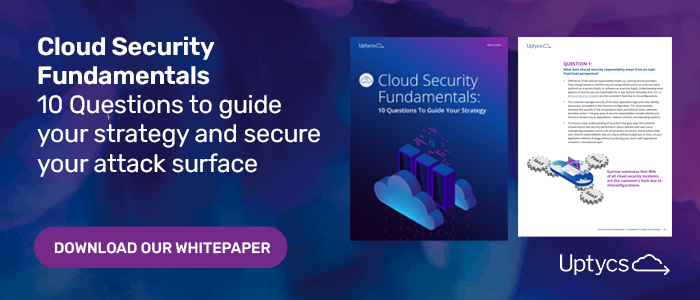Digital transformation was already happening, but the COVID pandemic kicked the transition into overdrive. Even companies that were cloud laggards were forced to adapt and adapt quickly.
With organizations moving to the cloud en masse and an increasing number of organizations fully cloud native, cybersecurity professionals must up their cloud security game. While a number of existing skills, tools and tech stacks can be adapted from on-prem to cloud, there remain unique challenges to cloud security that you must remain aware of.
Top 7 Cloud Security Issues
1. Shared Responsibility Model
The Shared Responsibility Model is what trips most organizations up when it comes to cloud. In fact, Gartner predicts that 99% of cloud security breaches will be the customer’s fault, stemming from misconfigurations. The Shared Responsibility Model, or some version of it, is used by most major cloud providers and outlines who is responsible for what when it comes to security. In a nutshell, the cloud provider is responsible for securing the cloud itself, but the customer is responsible for securing the contents of the cloud. This means firewalls, anti-malware, intrusion detection, and more. If your cloud security is not properly configured, your data could be at risk.
2. Lack of Visibility Into Cloud Data
Do you know what data you have in the cloud? Are you sure? As “cloud” has proliferated across all parts of the business, it’s more than just devops you need to be concerned about. Everything from employee PII to customer data to source code is now in the cloud, and must be defended. Understanding what you have in the cloud, applicable regulations, and how it’s protected is vital.
3. Lack of Real-Time Observability Into Cloud Security
Being able to observe activity in your cloud instances and deployments is key. Getting observability into real-time system activity allows security teams to see system processes, memory carving, and scanning for improved remediation, blocking, and even the ability to kill malicious processes in real time. Without ob
4. Incomplete Access Control
One of the biggest benefits of the cloud is that data can in theory be accessed anywhere, from any device without having to be onsite. And one of the downside risks from the cloud is that data can in theory be accessed from anywhere, from any device. With the disappearance of the on-prem security perimeter, properly managing access controls for the cloud has never been more important. Beyond multi-factor authentication (MFA), SSO, and per-app VPNs, actively maintaining limited user- or group-level access rosters is vital to ensure that only those with the need to access a given cloud deployment or resource are able to do so, and only from approved devices.
5. Lack of Skilled Cloud Security Staff
While some security skills from the legacy on-prem world are transferable to the cloud, the reality is that securing the cloud requires new skills, new techniques, and a different mindset. One of the biggest risks that organizations face when securing the cloud is either not recognizing the skills gap exists, or downplaying the severity of the risk it can present. Organizations must both invest in and require ongoing training and education for their security staff, and look for experienced cloud security professionals to lead the way and help create frameworks and establish best practices.
6. Shadow IT
Nobody likes to be “Mr. No” or the “Software Sheriff”– it’s a negative stereotype of security pro’s that has persisted for a long time now. But security staff must have control over cloud applications being provisioned throughout the organization. Without security staff having control over provisioning, sensitive data or unsecured app integrations could open the organization to risk. And again, since you can’t secure what you can’t see, it’s imperative that security teams maintain control and visibility into all cloud deployments, apps and instances used across the organization.
7. Regulatory Compliance
Regulatory compliance is one of the biggest reasons that some industries have delayed their transition to the cloud, despite the business advantages of doing so. In industries like healthcare, finance or payment processing, transitioning to the cloud can have profound effects on the ability to stay compliant with relevant rules and regs. Even organizations that participate in verticals that aren’t necessarily thought of as being heavily regulated, like retail, or do business overseas should do a review of their cloud deployments to ensure that sensitive information, PII, and other data is being properly stored and handled, and that devops is building regulatory compliance review into their requirements.
Conclusion
This is far from a comprehensive list of the top challenges facing cloud security teams, but it highlights some of the biggest primary issues that organizations may face. The cloud can literally revolutionize business by making processes and development faster, cheaper and more adaptable, but if your security isn’t ready, it could also come at a high cost.








